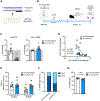miR-218 in Adolescence Predicts and Mediates Vulnerability to Stress
- PMID: 33384174
- PMCID: PMC8052258
- DOI: 10.1016/j.biopsych.2020.10.015
miR-218 in Adolescence Predicts and Mediates Vulnerability to Stress
Abstract
Background: Adolescence is a period of increased vulnerability to psychiatric disorders, including depression. Discovering novel biomarkers to identify individuals who are at high risk is very much needed. Our previous work shows that the microRNA miR-218 mediates susceptibility to stress and depression in adulthood by targeting the netrin-1 guidance cue receptor gene Dcc in the medial prefrontal cortex (mPFC).
Methods: Here, we investigated whether miR-218 regulates Dcc expression in adolescence and could serve as an early predictor of lifetime stress vulnerability in male mice.
Results: miR-218 expression in the mPFC increases from early adolescence to adulthood and correlates negatively with Dcc levels. In blood, postnatal miR-218 expression parallels changes occurring in the mPFC. Notably, circulating miR-218 levels in adolescence associate with vulnerability to social defeat stress in adulthood, with high levels associated with social avoidance severity. Indeed, downregulation of miR-218 in the mPFC in adolescence promotes resilience to stress in adulthood.
Conclusions: miR-218 expression in adolescence may serve both as a marker of risk and as a target for early interventions.
Keywords: Biomarkers; Chronic social defeat stress; Guidance cues; Netrin-1/DCC pathway; Prefrontal cortex; Resilience.
Copyright © 2020 Society of Biological Psychiatry. Published by Elsevier Inc. All rights reserved.
Conflict of interest statement
The authors report no biomedical financial interests or potential conflicts of interest.
Figures



Similar articles
-
MicroRNA regulation of prefrontal cortex development and psychiatric risk in adolescence.Semin Cell Dev Biol. 2021 Oct;118:83-91. doi: 10.1016/j.semcdb.2021.04.011. Epub 2021 Apr 28. Semin Cell Dev Biol. 2021. PMID: 33933350 Free PMC article. Review.
-
MiR-218: a molecular switch and potential biomarker of susceptibility to stress.Mol Psychiatry. 2020 May;25(5):951-964. doi: 10.1038/s41380-019-0421-5. Epub 2019 Apr 12. Mol Psychiatry. 2020. PMID: 30980043 Free PMC article.
-
Unique effects of social defeat stress in adolescent male mice on the Netrin-1/DCC pathway, prefrontal cortex dopamine and cognition (Social stress in adolescent vs. adult male mice).eNeuro. 2021 Feb 12;8(2):ENEURO.0045-21.2021. doi: 10.1523/ENEURO.0045-21.2021. Online ahead of print. eNeuro. 2021. PMID: 33619036 Free PMC article.
-
DCC Confers Susceptibility to Depression-like Behaviors in Humans and Mice and Is Regulated by miR-218.Biol Psychiatry. 2017 Feb 15;81(4):306-315. doi: 10.1016/j.biopsych.2016.08.017. Epub 2016 Aug 18. Biol Psychiatry. 2017. PMID: 27773352 Free PMC article.
-
The Netrin-1/DCC Guidance Cue Pathway as a Molecular Target in Depression: Translational Evidence.Biol Psychiatry. 2020 Oct 15;88(8):611-624. doi: 10.1016/j.biopsych.2020.04.025. Epub 2020 May 11. Biol Psychiatry. 2020. PMID: 32593422 Free PMC article. Review.
Cited by
-
MicroRNA regulation of prefrontal cortex development and psychiatric risk in adolescence.Semin Cell Dev Biol. 2021 Oct;118:83-91. doi: 10.1016/j.semcdb.2021.04.011. Epub 2021 Apr 28. Semin Cell Dev Biol. 2021. PMID: 33933350 Free PMC article. Review.
-
Stress, microRNAs, and stress-related psychiatric disorders: an overview.Mol Psychiatry. 2023 Dec;28(12):4977-4994. doi: 10.1038/s41380-023-02139-3. Epub 2023 Jun 30. Mol Psychiatry. 2023. PMID: 37391530 Review.
-
Perspective on adolescent psychiatric illness and emerging role of microRNAs as biomarkers of risk.J Psychiatry Neurosci. 2024 Aug 29;49(4):E282-E288. doi: 10.1503/jpn.240072. Print 2024 Jul-Aug. J Psychiatry Neurosci. 2024. PMID: 39209460 Free PMC article. No abstract available.
-
Peripheral MicroRNA Signatures in Adolescent Depression.Biol Psychiatry Glob Open Sci. 2025 Apr 14;5(4):100505. doi: 10.1016/j.bpsgos.2025.100505. eCollection 2025 Jul. Biol Psychiatry Glob Open Sci. 2025. PMID: 40519638 Free PMC article.
-
Neurobiology of resilience to early life stress.Neuropsychopharmacology. 2025 Jun 25. doi: 10.1038/s41386-025-02158-4. Online ahead of print. Neuropsychopharmacology. 2025. PMID: 40562842 Review.
References
-
- Birmaher B, Brent D (2007): Practice Parameter for the Assessment and Treatment of Children and Adolescents With Depressive Disorders. Journal of the American Academy of Child & Adolescent Psychiatry. 46:1503–1526. - PubMed
-
- Davey CG, Yücel M, Allen NB (2008): The emergence of depression in adolescence: Development of the prefrontal cortex and the representation of reward. Neuroscience & Biobehavioral Reviews. 32:1–19. - PubMed
Publication types
MeSH terms
Substances
Grants and funding
LinkOut - more resources
Full Text Sources

